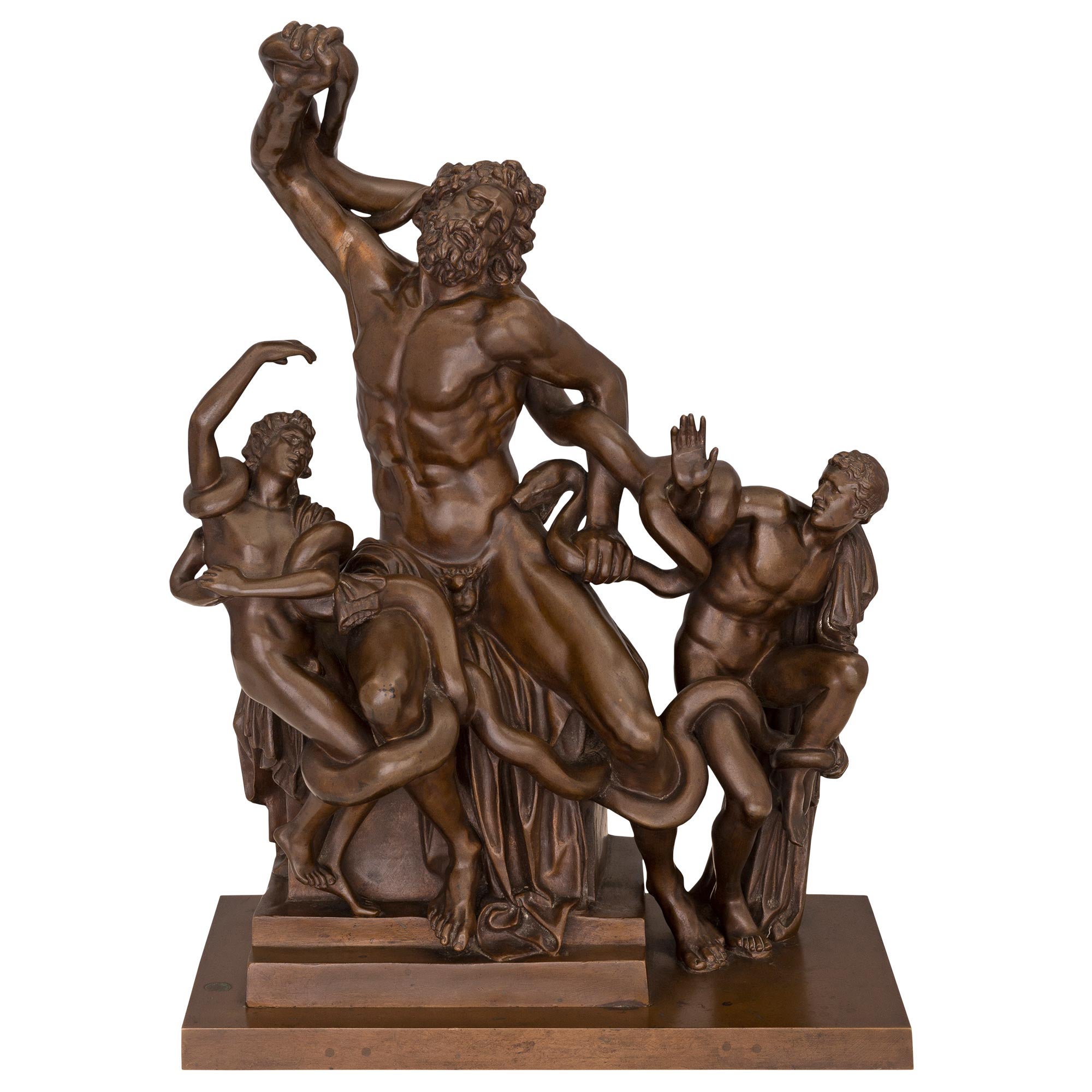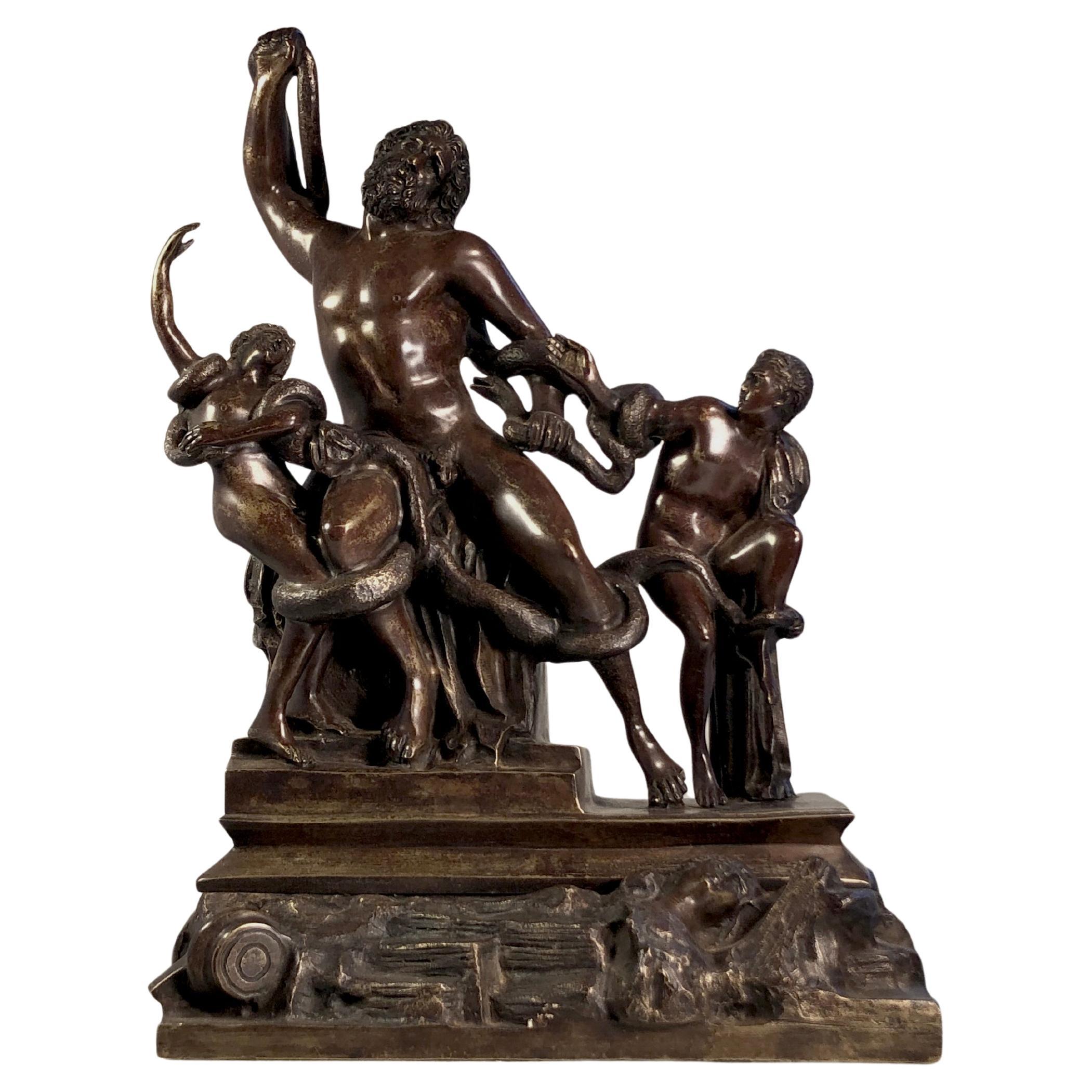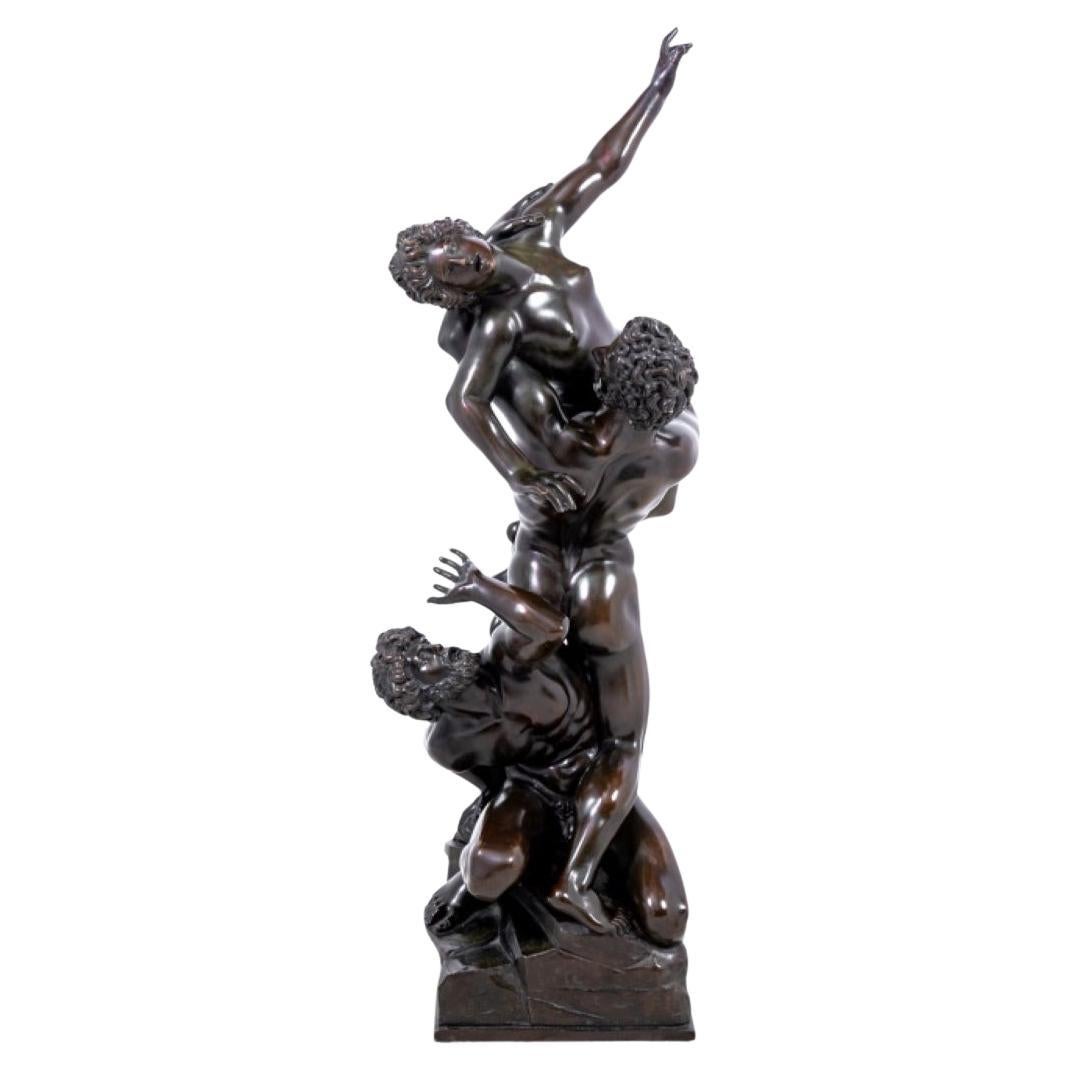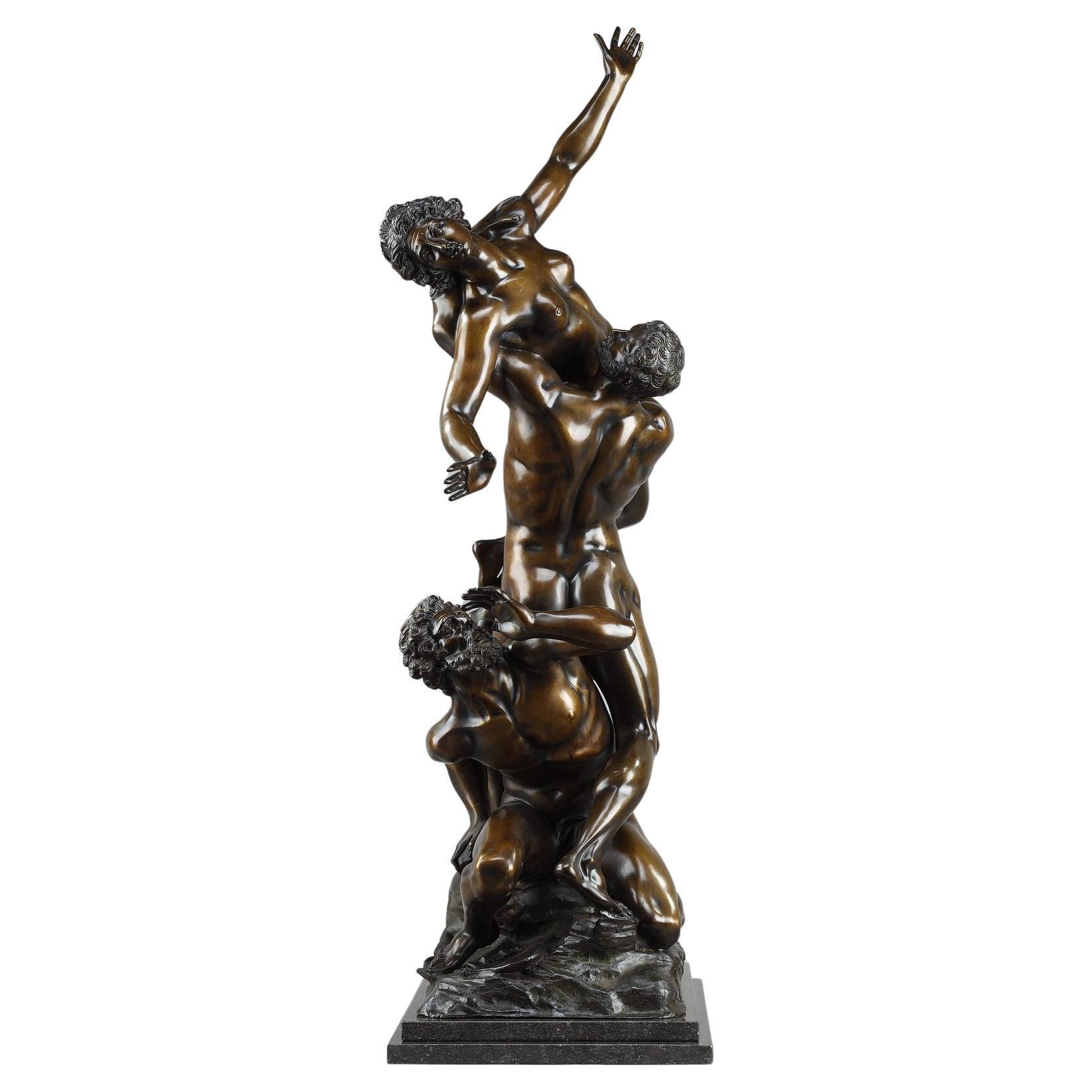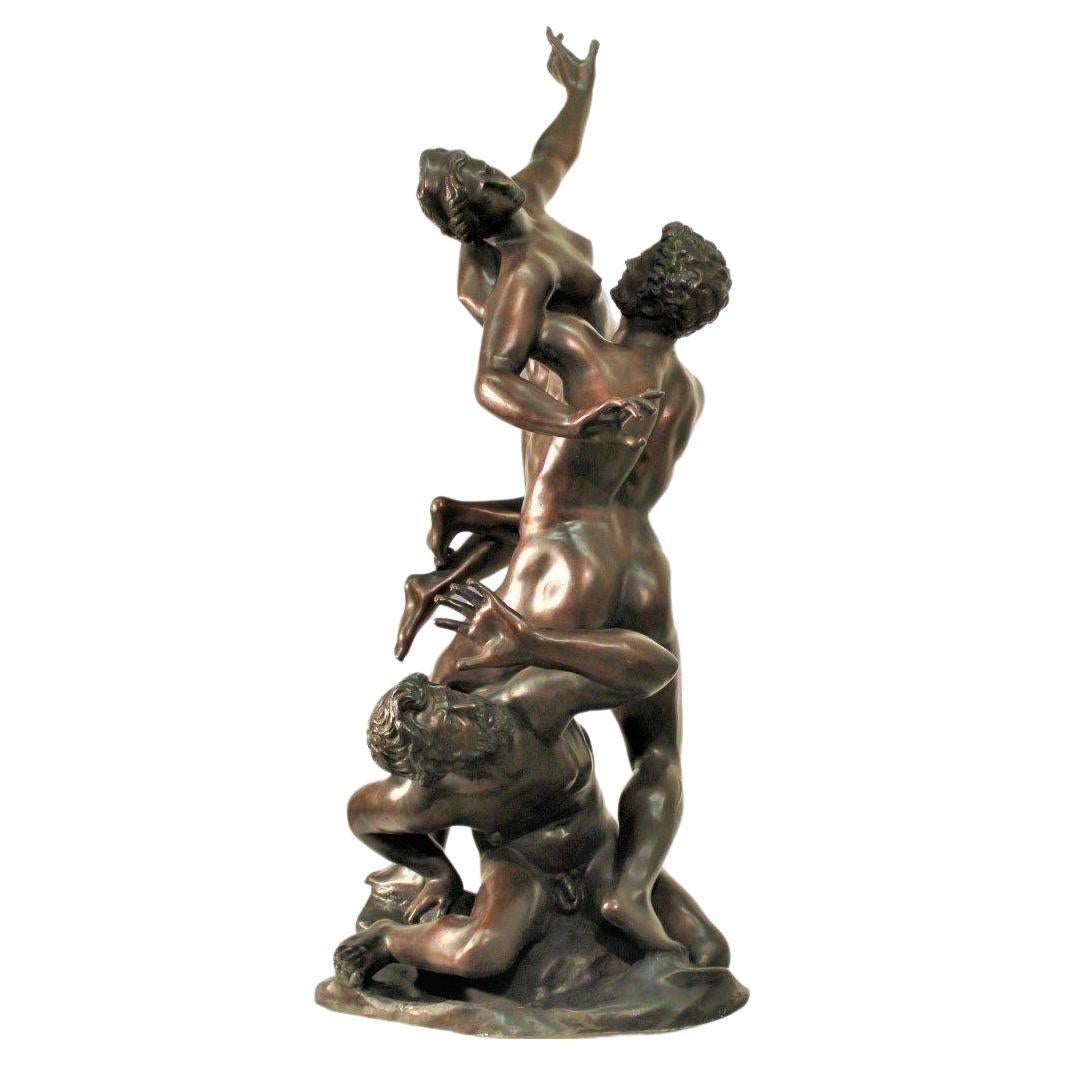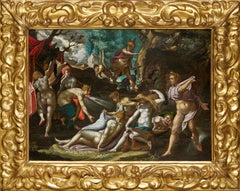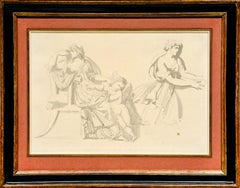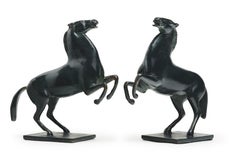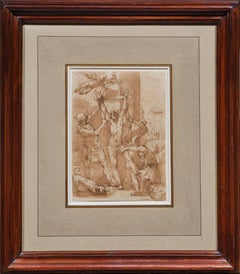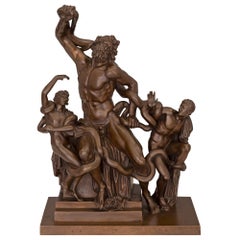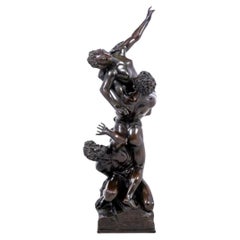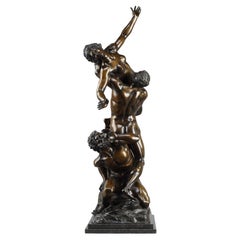Items Similar to Laocoön and his Sons, an exceptional bronze sculpture by Giacomo Zoffoli
Want more images or videos?
Request additional images or videos from the seller
1 of 11
Giacomo ZoffoliLaocoön and his Sons, an exceptional bronze sculpture by Giacomo Zoffolicirca 1775 - 1785
circa 1775 - 1785
$79,157.32
£59,333.32
€67,000
CA$108,748.71
A$121,407.70
CHF 63,615.81
MX$1,486,149.45
NOK 807,921.43
SEK 761,767.33
DKK 510,028.44
Shipping
Retrieving quote...The 1stDibs Promise:
Authenticity Guarantee,
Money-Back Guarantee,
24-Hour Cancellation
About the Item
This exceptional bronze group (unpublished), executed in Rome in the second half of the 18th century, bears witness to the fascination with the Laocoön since its discovery on January 14, 1506 on the Esquiline, the site of Nero's Golden House and Titus' baths.
The Grand Tour, the initiatic journey undertaken by young English aristocrats, led to the development in Rome of workshops specializing in antique reproductions. The Zoffoli workshop was the first to receive its patent in 1775; this Laocoön (of which we have identified only two copies, including the one we are presenting) is one of the most prestigious pieces produced by the Zoffoli, as attested by their signature on its side.
1. The Laocoon, a famous group from Antiquity
Appearing in the Little Iliad by Arctinos of Miletus, an epic poet of the 8th or 7th century BC, and repeated in the famous account of Troy's destruction by Aeneas in Dido's palace, in Canto II of Virgil's Aeneid, the story of Laocoön is that of a priest of Poseidon (or Apollo) who dies smothered by two snakes emerging from the sea after warning the Trojans against the Trojan Horse, which had been deposited on the shore as an offering to Poseidon. His two accompanying sons also fall prey to the same monsters.
The discovery in 1506 of fragments of a colossal marble group depicting Lacoön was a real event: a link was immediately established with the statue mentioned by Pliny the Elder in Book XXVI of his Natural History. He claims to have seen a sculpture featuring Laocoön and his Sons caught in the rings of prodigious reptiles in the house of Titus, and attributes this sculpture to the three sculptors Hagèsandros, Polydôros and Athanadôros, all from Rhodes. However, the analysis of the monument reveals that, contrary to what Pliny the Elder wrote, it is composed of several blocks of marble, and not carved from a single block ("ex uno lapide"). This point has led to controversy over the exact nature of the discovery: was it indeed the marble admired by Pliny the Elder, or just a copy?
This controversy took a new turn after the discovery of a stone bearing the signatures of the three artists cited by Pliny the Elder in connection with the Laocoön, in the grotto of Sperlonga, south of Rome, which was part of a villa last built by the emperor Tiberius.
Since then, two main theories have been put forward, with no decisive evidence to support a definitive choice. For some, the Vatican marble is a copy made by Rhodian sculptors at the beginning of the 1er century, at the time of Tiberius, from a bronze (now lost) executed around 140 BC in Pergamon. This sculpture would then have been handed down to Titus. For the others, the Laocoon is indeed a creation produced between 40 and 20 BC by the three Rhodian sculptors established in Italy since the middle of the 1er century BC.
Whatever its date of creation, this sculpture was executed with immense virtuosity, and the sculptors succeeded in extracting complex, expressive forms from the marble that still touch us today. A tour de force without equal in antique statuary, this group has been the object of fascination ever since its creation, as evidenced by the admiration of Pliny the Elder, Michelangelo and Goethe.
2. An eventful history since its rediscovery
The genesis of the group's reconstruction from fragments found on the Esquiline is poorlydocumented, although the names of Baccio Bandinelli and Giovanni Angelo Montorsoli, one of Michelangelo's collaborators, have been put forward. The discovery by L. Pollack in 1905 of Laocoon's right arm amidst the antique debris of a Roman stonemason’s workshop remains an astonishing milestone in the reconstruction of the group. The arm was reinstalled as part of a complete restoration of the monumental group between 1957 and 1959 (as shown in the last photography of the gallery).
The more bent-back position of the arm placed Laocoön's hand at the nape of his neck. This position is more consistent with the strong contraction of his torso muscles. Our bronze is an interesting testimony of the historical state, prior to this reintegration, of this much-admired group since its rediscovery during the Renaissance.
The quality of the Laocoön has always aroused covetousness. The King of France Francis 1st wished to acquire it and Pope Clement VII proposed him a copy, which was completed by Baccio Bandinelli in 1525. The quality of this copy led the Pope to change his mind : this statue became part of his family's collections in Florence (where it is still kept at the Uffizi Museum) and Clement VII sent some other antique statues to the King. François 1st nevertheless obtained the right to have a plaster cast made around 1540, under the direction of Primaticcio, from which the bronze preserved until now at Château de Fontainebleau is derived.
Napoleon completed François 1st's dream and brought the Laocoön back to Paris to adorn the Louvre National Museum; however, the group was returned to the Vatican's Pio-Clementin Museum after the emperor's abdication in 1815.
3. A major source of inspiration since the Renaissance
The statue's impact on the history of the arts is considerable: while numerous sculptors (Sansovino, Susini...) created small-scale bronzes inspired by the Laocoön as early as the Renaissance, the group also greatly inspired draftsmen, engravers and painters through the distribution of these engravings. In addition to the Greco's Laocoön, Laocoön's position can also be found in paintings as diverse as Titian's Coronation of Thorns and Rubens' Hercules and Omphale, to name just two examples in the Louvre.
This vogue for the Laocoön was of course exacerbated when, in the second half of the 18th century, Rome became, along with Naples and ahead of Venice, the main destination for young aristocrats on their Grand Tour. A good illustration of this craze is Pompeo Batoni's portrait of Thomas Dundas, executed in 1764 in Rome, with the Laocoön in the background.
4. A masterpiece from the Zoffoli workshop, of outstanding rarity
The development of Grand Tour "tourism" also spawned a souvenir industry. Aimed at a wealthy clientele, they were often made from precious materials (marble, bronze, hard stones, porcelain). The Zoffoli brothers were the first to open a workshop offering bronze reproductions of antiques, followed by the Righetti family, who obtained their patent in 1783, then by the Volpato family, who founded a porcelain factory in 1785, and finally by Giuseppe Boschi, who was active between 1785 and 1810.
The quality of the Zoffoli brothers' bronzes had already impressed their contemporaries. In 1795, Charles Heathcote Tatham wrote to Henry Holland: "the bronze used by the Italians [in comparison with French foundries] is of the best metal, with what they call a patina, meaning the outward color, of a good nature [...] and above all their execution is superlatively good, having artists employed who study the antique with attention and model with great ingenuity and taste".
As evidence of the Zoffoli brothers' activity, we have a catalog of their productions , in which our Laocoön appears at the top of the list, to the right of the no less famous Apollo of Belvedere. Offered at a price of 50 gold sequins, while the Apollo cost was only 16 sequins, the Laocoön was the second most expensive item, after the statues of Orestes and Electra from the Ludovisi collection, which were offered at 80 sequins (no copy of which has been found).
This high price probably explains why so few copies are known today, as we have only found another one, also signed by Zoffoli, with a slightly different signature. At the time of its presentation for sale at Sotheby's in London in April 2004, the catalog editor believed it to be a unique example, based on his exhaustive survey of major collections of Zoffoli bronzes, such as those held at Saltram Park (Devon - UK), the Nationalsmuseum in Stockholm (Sweden) and Schloss Wörlitz (Dessau - Germany).
Also featured prominently in this catalog was a pair of Centaurs, known as Capitoline or Furietti (after their first owner), which was sold for 45 gold sequins. A pair of these Centaurs sold for the equivalent of €156,750 on November 9, 2012 at Sotheby's.
This pair of centaurs has in common with our Laocoön a black patina (probably executed in the 19th century), under which the orange sheen of the bronze can be seen. The quality of execution of the details in our copy, which was probably achieved by the meticulous assembly of 6 or 7 separately cast pieces, is remarkable from every point of view. Below are a few photos (featuring the head of Laocoön, the one of his son or details of the snake, the toenails, and the finesse of the armature) which illustrate the extraordinary quality of execution of this piece.
Main bibliographical references :
H. Honour - Bronze statuettes by Giacomo and Giovanni Zoffoli - The Connoisseur, November 1961, pages 198 - 205
F. Haskell & N. Penny - Taste and the Antique - Newhaven & London 1981
I. Pfeiffer - Giacomo Zoffoli. Kleinbronzen aus Schloss Wörlitz - Weltkuntz - December 24, 1996 pages 3232 - 3234
J.P. Cuzin, J.R. Gaborit, A. Pasquier - D'après l'Antique - catalog of the Musée du Louvre exhibition (October 16, 2000 to January 15, 2001) - RMN, 2012
A. Hilliam - Longing for the Antique: Collecting the bronze statuettes of eighteenth-century Rome - Master of Studies, University of Oxford 2013
- Creator:Giacomo Zoffoli (1731 - 1785, French)
- Creation Year:circa 1775 - 1785
- Dimensions:Height: 10.13 in (25.74 cm)Width: 14.82 in (37.65 cm)Depth: 6.5 in (16.51 cm)
- Medium:
- Movement & Style:
- Period:1770-1779
- Condition:Signed on the base: GIACOMO : ZOFFOLI : F Provenance : private collection - Paris - France.
- Gallery Location:PARIS, FR
- Reference Number:1stDibs: LU1568213166252
About the Seller
5.0
Vetted Professional Seller
Every seller passes strict standards for authenticity and reliability
Established in 2020
1stDibs seller since 2021
10 sales on 1stDibs
Typical response time: 2 hours
- ShippingRetrieving quote...Shipping from: PARIS, France
- Return Policy
Authenticity Guarantee
In the unlikely event there’s an issue with an item’s authenticity, contact us within 1 year for a full refund. DetailsMoney-Back Guarantee
If your item is not as described, is damaged in transit, or does not arrive, contact us within 7 days for a full refund. Details24-Hour Cancellation
You have a 24-hour grace period in which to reconsider your purchase, with no questions asked.Vetted Professional Sellers
Our world-class sellers must adhere to strict standards for service and quality, maintaining the integrity of our listings.Price-Match Guarantee
If you find that a seller listed the same item for a lower price elsewhere, we’ll match it.Trusted Global Delivery
Our best-in-class carrier network provides specialized shipping options worldwide, including custom delivery.More From This Seller
View AllDiana and Actaeon, a Mannerist painting after Joseph Heintz the Elder
Located in PARIS, FR
This painting seduced us with its rich colors. Depicting Diana and her companions surprised by Actaeon, it was inspired by an engraving by Aegidius Sadeler II after a painting by Jos...
Category
17th Century Old Masters Nude Paintings
Materials
Oil, Wood Panel
Frieze of antique figures, a drawing by the sculptor Antoine-Denis Chaudet
Located in PARIS, FR
Faithful to the neo-classical taste, sculptor Antoine-Denis Chaudet presents us with a frieze of antique figures executed in gray wash over pencil strokes, which is likely inspired b...
Category
Early 1800s Old Masters Figurative Drawings and Watercolors
Materials
Paper, Pencil, Ink
Pair of Prancing Horses, two bronzes signed and numbered by Arno Breker
Located in PARIS, FR
An official artist of the Nazi regime, trained in Montparnasse in the 1930s, Arno Breker continued to sculpt after the fall of the Third Reich, producing large-scale public commissions in Germany and portraits of prominent figures. The two small bronzes presented here, dated around 1978, are part of a long tradition of prancing horses dating back to antiquity. The asymmetrical treatment of the two front legs and the inclination of the head make these two copies of the same artwork a highly decorative pair.
1. Arno Breker, a prolific sculptor, from the Bohemia of Montparnasse to the commissions from the Third Reich ... and from the Federal Republic of Germany
The son of a stone carver, Arno Breker studied fine art and anatomy in his native Elberfeld. At the age of 20, he entered the Düsseldorf Academy of Art. He moved to Paris in 1926, where he continued his training in the studio of Maillol, who dubbed him "the German Michelangelo of the twentieth century". He shared a studio with Alexandre Calder and frequented Jean Cocteau, Foujita, Brancusi, Pablo Picasso and other artists of the bohemian Paris of the time. It was also in Paris in 1933 that he met Demetra Messala, the daughter of a Greek diplomat who posed for Maillol and Picasso, whom he married in 1937. Having won the Prussian Prix de Rome in 1932, he left Paris to stay at the Villa Massimo, the German Academy in Rome.
Returning to Germany in 1934, his style evolved towards a more marked imitation of ancient sculpture. He created two monumental statues for Berlin's Olympic Stadium, before being appointed professor at the Berlin College of Fine Arts in 1937. He came to the attention of the Reich Propaganda Ministry, which awarded him several commissions and provided him with three large studios in which Breker produced many monumental sculptures to the glory of the regime. On June 23, 1940, Breker accompanied Adolf Hitler during a visit to Paris. During the Occupation, his political connections enabled him to intervene on behalf of many artists pursued by the Nazis: for example, he protected Pablo Picasso (then a Communist) from Kommandantur officers.
Most of Arno Breker's work was destroyed in Berlin at the end of the war in 1945 by bombing and intentional destruction perpetrated by soldiers of the victorious powers. After the fall of the Nazi regime, however, Arno Breker was never prosecuted. He opened a new studio in Düsseldorf, where he sculpted until his death in 1991.
He then carried out several public commissions in Germany (Bayreuth, Wuppertal), as well as portraits of numerous personalities, including King Mohammed V of Morocco, Léopold Sedar Senghor (commissioned by the Académie Française in 1978) and the two chancellors of the Federal Republic of Germany, Konrad Adenauer and Ludwig Erhard. The Arno Breker Museum in Nörvenich is now exhibiting some of his artworks.
2. Related artworks: from the Wild Horses of the Quirinal to the Horses of Marly
The prancing horse is a major iconographic theme, found in a series of sculptures from Antiquity, the Renaissance and the Classical Age. Various photos from Arno Breker's studio in Berlin confirm the predominant place of equine representations in his work (alongside male nude statues), and confirm that this reduced version created in 1978 is part of the artist's preferred repertoire.
Prancing horses are generally associated with a male figure in a group that, through a reference drawn from Antiquity, symbolizes man's domination over nature. In this respect, it is very interesting to compare our small bronzes with the horse forming part of a large sculpture by Arno Breker (made in 1936 and probably destroyed in 1945) depicting Alexander taming Bucephalus.
This statue is itself directly inspired by one of the best-known works of 18th-century French sculpture...
Category
1970s Art Deco Figurative Sculptures
Materials
Bronze
The Martyrdom of Saint Bartholomew, a preparatory drawing by Alessandro Casolani
Located in PARIS, FR
This powerful pen and brown ink wash drawing is a study for an altarpiece depicting The Martyrdom of Saint Bartholomew. Signed and dated 1604, it was painted at the end of his life b...
Category
Early 1600s Old Masters Figurative Drawings and Watercolors
Materials
Ink, Pen
Allegory of the Treaty of Angoulême, a drawing attributed to Donato Mascagni
Located in PARIS, FR
We would like to thank Mrs. Ursula Verena Fischer Pace for suggesting the attribution to Donato Arsenio Mascagni.
We were immediately seduced by the rich tonalities of this allegory...
Category
1620s Old Masters Figurative Drawings and Watercolors
Materials
Ink
Three drawings by François Boucher in a mounting by Jean-Baptiste Glomy
By François Boucher
Located in PARIS, FR
We would like to thank Juliette Parmentier-Courreau of the Custodia Foundation for her welcome and support during the consultation of Glomy’s Journal des Ouvrages.
This spectacularly large "feuille de desseins ajustés" commissioned by François Boucher from Jean-Baptiste Glomy is emblematic of the painter's art and mastery of rocaille. It is also fully representative of the taste of this period in the field of decorative arts. The largest of these three drawings, placed at the bottom of the composition, is particularly interesting: dating from around 1756, it constitutes a modello (apparently unpublished) for the frontispiece of the "Catalogue des tableaux de Monsieur de Julienne"), preserved in the Morgan Library in New York.
1. François Boucher, the master of French rocaille
The extraordinary career of Francois Boucher was unmatched by his contemporaries in versatility, consistency and output. For many, particularly the writers and collectors who led the revival of interest in the French rococo during the last century, his sensuous beauties and plump cupids represent the French eighteenth century at its most typical. His facility with the brush, even when betraying the occasional superficiality of his art, enabled him to master every aspect of painting – history and mythology, portraiture, landscape, ordinary life and, as part of larger compositions, even still life. He had been trained as an engraver, and the skills of a draftsman, which he imbued in the studio of Jean-Francois Cars (1661 – 1738), stood him in good stead throughout his career; his delightful drawings are one of the most sought-after aspects of his oeuvre.
As a student of Francois Lemoyne (1688 - 1737), he mastered the art of composition. The four years he spent in Italy, from 1727-1731, educated him in the works of the masters, classics and history, that his modest upbringing had denied him.
On his return to Paris in 1734, he gained full membership of the Royal Academy of Painting and Sculpture with his splendid Rinaldo and Armida (Paris, Musée du Louvre). Although, throughout his career, he occasionally painted subjects taken from the Bible, and would always have considered himself first as a history painter, his own repertoire of heroines, seductresses, flirtatious peasant girls and erotic beauties was better suited to a lighter, more decorative subject matter. His mastery of technique and composition enabled him to move from large scale tapestry...
Category
1750s Old Masters Figurative Drawings and Watercolors
Materials
Chalk, Ink
You May Also Like
French 19th Century Patinated Bronze Statue of Laocoön and His Sons
By Ferdinand Barbedienne
Located in West Palm Beach, FL
A most impressive and high quality French 19th century patinated bronze statue of Laocoön and his sons, signed Barbedienne. The bronze is raised b...
Category
Antique 19th Century French Figurative Sculptures
Materials
Bronze
THE LAOCOON GROUP Bronze SCULPTURE by FONDERIA CHIURAZZI, Italy 1880-1890
By Fonderia Chiurazzi
Located in PARIS, FR
A patinated bronze sculpture reproduction of the Laocoon group by the Napolitan world famous Fonderia Chiurazzi, Italy 1880-1900.
Rediscovered in 1506 in Rome The Laocoon Group is believed to be created sometime between 42-20 BCE by three sculptors from Rhodos – Hagesander, Athenodoros and Polydorus, after the work of more ancien Hellenistic sculptors.
Recreated and issued (with several sizes and creative variations) by Fonderia Chiurrazzi, this piece is more than just an incredibly precise and expressive reproduction of the iconic antic sculpture...
Category
Antique 1880s Italian Neoclassical Figurative Sculptures
Materials
Bronze
Giambologna "Rape of the Sabine Woman" Bronze
By Jean de Bologne
Located in Astoria, NY
After Giambologna (Jean de Boulogne, Italian, 1529-1608) "Rape of the Sabine Woman" Patinated Bronze Sculpture, French, late 19th century. 42.5" H x 12" W x 12" D. Note: This bronze ...
Category
Antique 19th Century Figurative Sculptures
Materials
Bronze
Very Large Bronze "Abduction of a Sabine Woman" After Giambologna, 19th Cent
By Giambologna, Ferdinando de Luca
Located in Paris, FR
Very large bronze sculpture with brown patina, based on the group "The Rape of the Sabine Women" by John of Bologna (Giambologna). This pivoting composition shows three figures in motion: a man on the ground defeated with his shield turned upside down, a second one arched clutching a woman launched towards the sky trying to escape, all on a naturalistic base. The Sabine man, the Roman and the Sabine woman are all depicted naked. This staging plays on serpentine lines known as "figura serpentinata" and diagonals giving a beautiful variety of volumes and a multiplicity of angles of view. The bronze is signed F. De Luca...
Category
Antique 1880s French Baroque Figurative Sculptures
Materials
Bronze
After Giambologna, the Rape of the Sabine Women
Located in Rome, IT
Sculpture, large sculptural group "The rape of the Sabine women".
Category
Vintage 1980s Italian Busts
Materials
Bronze
$11,341 Sale Price
20% Off
The Rape of Sabine Iconic Bronze Sculpture 1930
Located in Rome, IT
Fine Group of Sculptures in Bronze after Jean de Boulogne (Giambologna)
The torturously twisting Rape of the Sabine Women is one of the finest and most technically difficult sculpt...
Category
1920s Mannerist Figurative Sculptures
Materials
Bronze
$7,561 Sale Price
20% Off
More Ways To Browse
Antique Bronze Sculpture Signed Art Sculptures
Antique Metal Sculpture
Antique Bronze Sculpture Artists
Antique Sculptures London
Most Expensive Item
Arm Sculpture
Marble Sculpture Nude
Antique Bronze Nude
Bronze Sculpture 18th Century
Marble Sculpture Fragment
Orange Metal Sculpture
Angelo Metal Art
Renaissance Art Pairings
Napoleon French Bronze Sculpture
Black Bronze Nudes
Reproduction Bronze Sculpture
Roman Head Sculpture
Metal Bear Sculpture
